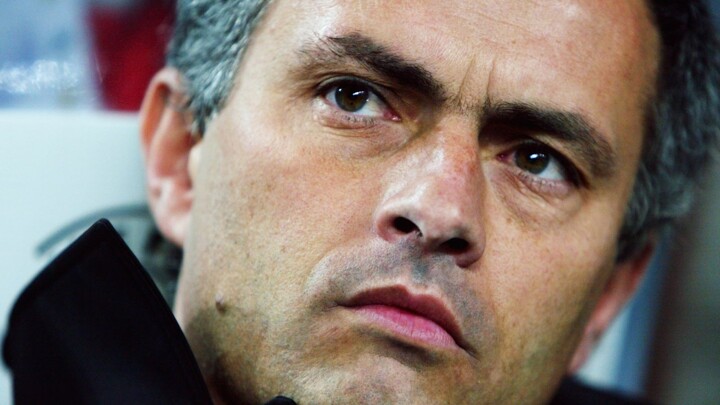Former Chelsea and Man Utd manager Jose Mourinho takes charge of his 1,000th game when Roma face Sassuolo on Sunday; his extraordinary managerial career is a story of dizzying highs and bruising lows; it all began with a whirlwind spell in charge of Benfica.

In the context of a managerial career spanning 1,000 games, it would be easy to overlook the first 11. To many, Jose Mourinho's rise to greatness began with his trophy-laden spell at Porto. But before that, before everything, there was Benfica.
Mourinho took over at Estadio da Luz in September 2000 and was gone just three months later. But not because of poor results. In fact, he departed with his reputation enhanced. His brief tenure, and its explosive end, sowed the seeds for what was to come.
Benfica were gripped by crisis at the time. It had been six years since their last title and their finances were in a dire state. Joao Vale e Azevedo, the club's president, had sacked Jupp Heynckes and needed a coach to reinvigorate the side with no investment.
He settled on a 37-year-old Mourinho.
The Portuguese had spent the previous four seasons serving as assistant to Sir Bobby Robson and then Louis van Gaal at Barcelona but left the club that summer intending to strike out on his own.
His appointment at Benfica raised eyebrows in his homeland. Mourinho had become known within the game as a forward-thinking coach with a bright future but it was a huge job for a managerial novice - especially given the circumstances.
Mourinho was undeterred, however, and signed a six-month contract which would be extended for two years should Vale e Azevedo win the upcoming presidential election. Fatefully, he didn't, paving the way for Mourinho's exit. But a lot happened in between.
In Jose Mourinho, the 2005 biography written by his friend Luis Lourenco, Mourinho describes inheriting a "weak squad with no future and no ambition". The players were "used to losing", "worked little", and "didn't really care", he added.
Mourinho's first impressions of the squad - or, "bunch of players", as he preferred to call them - were cemented when Benfica slumped to a meek 1-0 loss against Boavista in his opening game in charge.
Mourinho was dismayed not just by the side's performance in that game but by the general lack of intensity and aggression in training. He soon resolved to shake things up.
There were certain senior players he felt he could trust, among them striker Pierre van Hooijdonk, whose spiky personality he loved, midfielder Maniche, who would later follow him to Porto and Chelsea, and the now deceased goalkeeper Robert Enke.
For the rest, though, he turned to the club's academy.

Left-back Diogo Luis was one of the players he promoted.
"It was perfect for me and for all the academy players because we understood that it was possible for us to live our dream, to go to the first team,"
"Mourinho didn't look at names; he looked at other qualities. For him, it wasn't important whether you were a 28-year-old Portugal international or a young player from the B team.
"What was important to him was how you performed in the training sessions. He wanted to find a way to make the side competitive, so he pushed young players up to give blood to the team."
The decision to promote youngsters was a bold one but it helped to change the culture around the training ground. And even at that early stage of his managerial career, Mourinho did not shy away from confronting the senior players who refused to fall in line.

During one game, he noted that former Egypt international Abdel Sattar Sabry, one of the club's biggest talents, had taken seven minutes to put on his boots and tie his laces after being told he would be coming on as a second-half substitute.
When the player's agent subsequently complained about his client's lack of game-time under the new coach, Luis recalls Mourinho making an example of him both in the dressing room and publicly.
"The next day, when Sabry came into the dressing room, Mourinho said to him, in front of all of us, 'Do you know how long you were tying your laces for? Seven minutes. Do you know when you are going to play for me again, if you have that mentality? Never.' He then went to his press conference and said the same thing.

"With that kind of approach, you win the dressing room," adds Luis, "because it means everyone is treated the same way. So, if you have a guy who thinks he is better than the rest, he won't fit.
"From then on, everyone knew that Mourinho was noticing every detail and we became stronger as a group."
Mourinho would go on to use similar techniques throughout his managerial career and his time at Benfica was also the first example of him creating a siege mentality.
The dressing room, previously accessible to club directors, became a sacred space for the players. Any criticism from outside, of which there was plenty in the early days of his tenure, was used as fuel for the 'us versus them' mentality Mourinho wanted to build.
"We started to have confidence in him because we understood he was protecting us and we didn't feel the same about the board of directors, who were always speaking in the press," says Luis.
Results soon improved - Benfica only lost one of the next 10 games under Mourinho following the defeat to Boavista - and it helped that he brought revolutionary training methods as well as discipline and togetherness.
In Lourenco's book, Mourinho describes training at Benfica at the time of his arrival as "a group of nice guys kicking a ball about a bit and doing some running" but he soon set about changing it.
